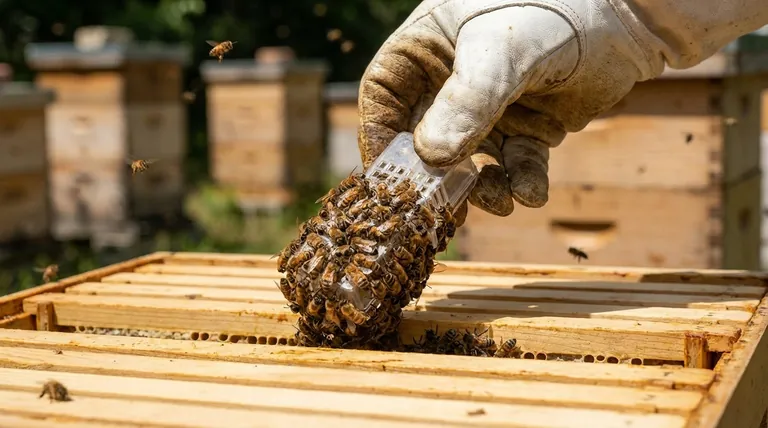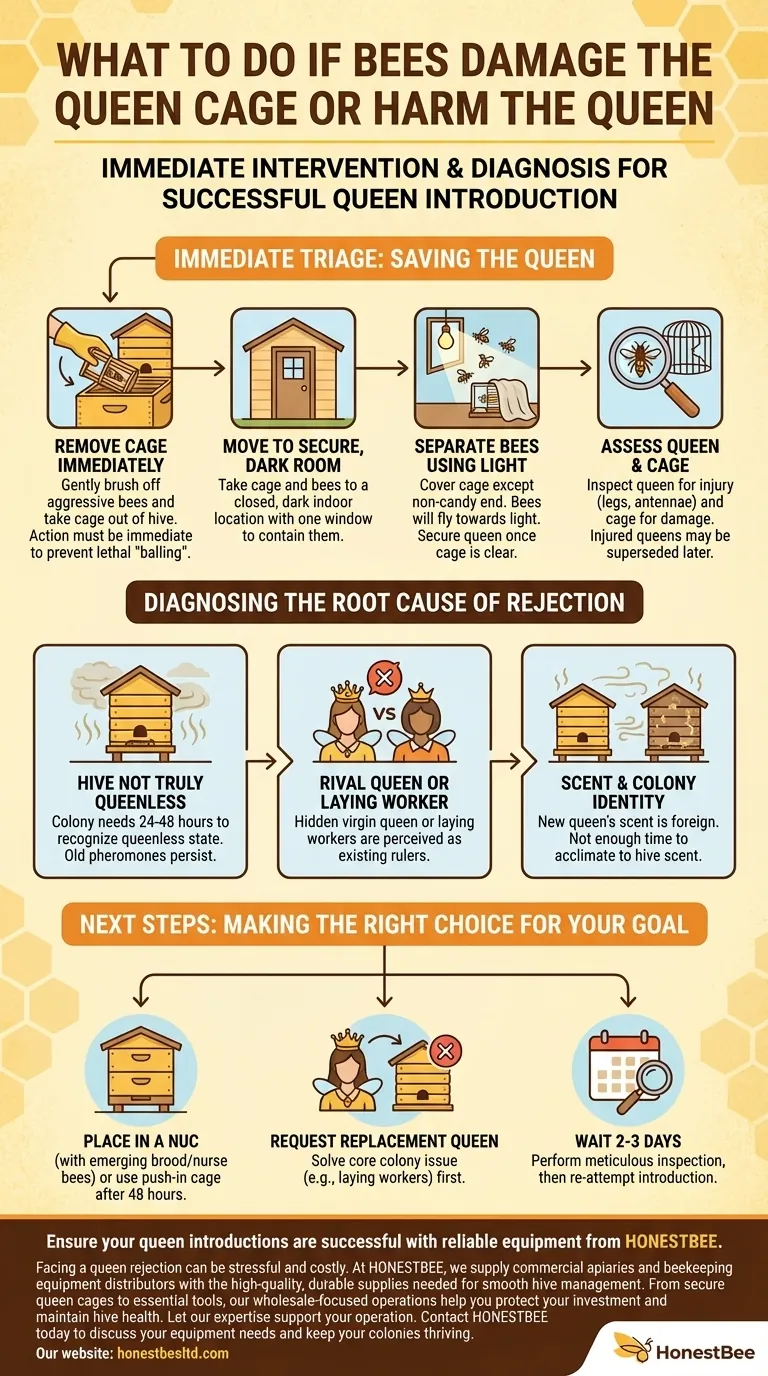If you see your bees attacking the queen cage, you must intervene immediately. This behavior, known as "balling," is an attempt to kill the new queen by overheating her. Your primary goal is to remove the cage from the hostile hive, safely separate the aggressive bees from the queen, and then reassess your introduction strategy before trying again.
A colony's aggression toward a new queen is not a random act; it is a clear signal that the hive is not yet ready to accept her. Your task is to rescue the queen from immediate danger and then diagnose the underlying reason for the rejection to ensure the next attempt succeeds.

Immediate Triage: Saving the Queen
When you see a ball of bees covering the queen cage, you are witnessing an emergency. Do not wait. Act calmly and deliberately by following these steps.
Step 1: Remove the Cage from the Hive
Your first action must be to remove the queen cage from the aggressive bees. Gently brush the bees off the cage and take it out of the hive completely. Leaving her there, even for a few more hours, will almost certainly result in her death.
Step 2: Move to a Secure, Indoor Location
Take the cage and the attached bees into a closed room, like a garage or shed, with a single window. This prevents the bees from flying off and allows you to contain them for the next step.
Step 3: Separate the Attacking Bees Using Light
Bees are naturally drawn to light (a behavior called phototaxis). You can use this to your advantage.
Darken the room and cover the queen cage with a cloth, leaving only the non-candy end exposed. Uncork this end. The bees inside the cage will see the light from the opening and fly out towards the window. Once the cage is clear of bees, you can safely secure the queen inside again.
Step 4: Assess the Queen and Cage
With the aggressive bees removed, carefully inspect the queen for any injuries, such as damaged legs or antennae. Also, check the cage itself for any damage to the screen or structure. A damaged queen may be rejected by the colony later, even if she is eventually introduced.
Diagnosing the Root Cause of Rejection
Understanding why the bees attacked is critical to preventing it from happening again. This aggression is a symptom of a deeper issue within the colony.
The Hive Isn't Truly Queenless
This is the most common reason for rejection. A hive must be queenless for at least 24-48 hours to fully recognize its state. If you introduce a new queen too soon after removing the old one, her lingering pheromones will cause the bees to see the new queen as an invader.
A Rival Queen or Laying Worker Exists
The colony will fiercely reject a new queen if they believe they already have one. This could be a hidden virgin queen that hasn't started laying yet, or "laying workers"—worker bees that have begun laying unfertilized (drone) eggs in a desperate attempt to propagate. A thorough hive inspection is necessary to rule this out.
Scent and Colony Identity
A new queen carries the scent of her original colony, marking her as a foreigner. A slow introduction is designed to let her scent dissipate and allow her to acquire the scent of her new hive. If the bees are particularly aggressive, it's a sign they have not had enough time to acclimate to her presence.
Understanding the Risks and Trade-offs
Simply putting the queen back in the hive after an attack is a recipe for failure. You must change your approach based on the information you now have.
The High Risk of a Second Attempt
If a colony has already demonstrated hostility, re-introducing the queen using the same method will likely yield the same result. The bees have already marked her as a threat.
The Danger of a Damaged Queen
Even if a slightly injured queen (e.g., a damaged leg) is eventually accepted and begins laying, the bees may perceive her as "faulty." They are likely to supersede her—kill her and raise a new queen of their own—within a few weeks or months.
The "Wait and See" Fallacy
Bee "balling" on a queen cage is not a minor issue or a temporary phase of getting acquainted. It is a direct and lethal assault. Waiting to see if they "calm down" is not a viable strategy and will lead to the loss of the queen.
Making the Right Choice for Your Goal
After rescuing the queen and diagnosing the likely problem, your next steps are about resetting the introduction process for success.
- If your primary focus is saving an uninjured queen: Place her in a small nucleus hive (a "nuc") with a frame of emerging brood and nurse bees, who are far more accepting, or wait 48 hours and re-introduce her to the original hive using a "push-in cage" that allows more direct but protected contact.
- If your primary focus is the long-term health of the colony: If the queen is injured or you are dealing with laying workers, it is often best to request a replacement queen and focus on solving the core colony issue before attempting another introduction.
- If you are unsure why she was rejected: The safest path is to wait an additional 2-3 days, perform a meticulous inspection for hidden queen cells or laying workers, and then re-attempt the introduction.
Understanding and responding to your bees' behavior is the foundation of successful queen management.
Summary Table:
| Action | Purpose | Key Consideration |
|---|---|---|
| Remove Cage Immediately | Prevent queen's death from "balling." | Do not wait; aggression is lethal. |
| Separate Bees Using Light | Safely remove attackers from the queen. | Use a dark room and a single light source. |
| Assess Queen & Cage | Check for injuries or damage that could cause future rejection. | An injured queen may be superseded later. |
| Diagnose Root Cause | Identify why the hive rejected her (e.g., not truly queenless). | Prevents the same problem on the next attempt. |
Ensure your queen introductions are successful with reliable equipment from HONESTBEE.
Facing a queen rejection can be stressful and costly. At HONESTBEE, we supply commercial apiaries and beekeeping equipment distributors with the high-quality, durable supplies needed for smooth hive management. From secure queen cages to essential tools, our wholesale-focused operations help you protect your investment and maintain hive health.
Let our expertise support your operation. Contact HONESTBEE today to discuss your equipment needs and keep your colonies thriving.
Visual Guide

Related Products
- Professional Multi-Functional Queen Bee Cage
- Durable Galvanized Steel Spring Queen Bee Cage
- Multi-Function Queen Roller Cage and Catcher
- Professional Multi-Compartment Queen Cage with Sliding Lid
- Professional Queen Cage with Sliding Gate and Feeder Plug
People Also Ask
- What is sequestration, and how does it help bees reorient? A Safer Guide to Hive Relocation
- How long does it typically take bees to adjust to a new queen? Master the 2-7 Day Acceptance Window
- What are the components of a standard queen cage? A Guide to Safe Queen Introduction
- What items are needed to place the queen bee's cage in the hive? A Guide to Successful Queen Introduction
- How do you check if the queen has been released after installation? A Guide to Successful Queen Acceptance



















